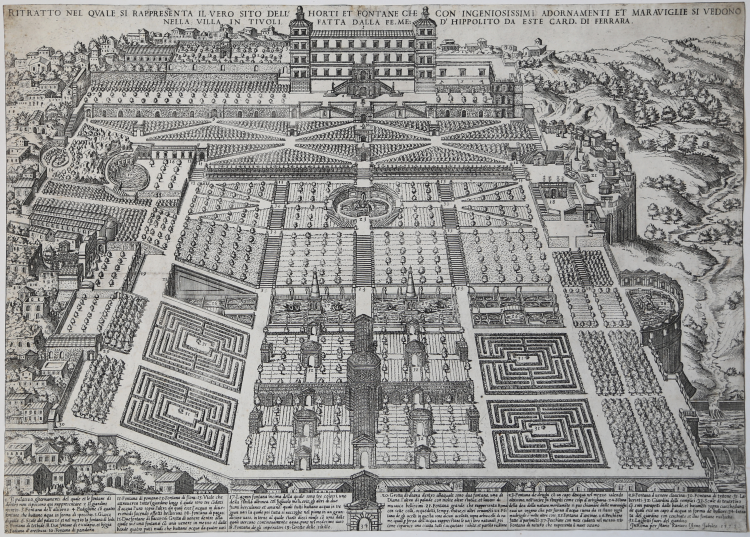




| Reference: | S40851 |
| Author | Mario CARTARO |
| Year: | 1575 |
| Zone: | Villa d'Este |
| Measures: | 515 x 370 mm |



| Reference: | S40851 |
| Author | Mario CARTARO |
| Year: | 1575 |
| Zone: | Villa d'Este |
| Measures: | 515 x 370 mm |
Etching and engraving, signed at bottom right: “In Rome for Mario Kartaro the year Jubileo 1575”. Part of Speculum Romanae Magnificentiae.
Inscribed at the top: “PORTRAIT IN THE QVALE IS REPRESENTING THE TRUE SITE OF THE HORTI, ET FONTANE WHICH WITH INGENIOSISIMOUS ADORNAMENTS AND MARAVIGLIE IS VILLA IN TIVOLI, DONE BY FE[LICE] ME[MORIA]D'HIPPOLITO DA ESTE CARD[INALE] DI FERRARA”.
After working at the Casino of Pius IV (1559-1565) in the Vatican, Pirro Ligorio worked at Villa d'Este in Tivoli. Ligorio's contribution doesn’t appear in the documents, but his position as antiquarian of Casa d'Este and the affinities of the Tiburtine villa with the Casino of Pius IV lead to attribute the arrangement of the villa to Ligorio. The works lasted from 1560 until the death of Ippolito d'Este (1572).
The first version, celebrating the complex of the villa with its gardens, is due to Étienne Du Pérac, published on April 8, 1573. Du Pérac had at his disposal the plans of Pirro Ligorio for the gardens of Villa d'Este. The replica by Mario Cartaro comes to light for the Jubilee of 1575.
The work belongs to the Speculum Romanae Magnificentiae, the earliest iconography of ancient Rome.
The Speculum originated in the publishing activities of Antonio Salamanca and Antonio Lafreri (Lafrery). During their Roman publishing careers, the two editors-who worked together between 1553 and 1563-started the production of prints of architecture, statuary, and city views related to ancient and modern Rome. The prints could be purchased individually by tourists and collectors, but they were also purchased in larger groups that were often bound together in an album. In 1573, Lafreri commissioned a frontispiece for this purpose, where the title Speculum Romanae Magnificentiae appears for the first time. Upon Lafreri's death, two-thirds of the existing copperplates went to the Duchetti family (Claudio and Stefano), while another third was distributed among several publishers. Claudio Duchetti continued the publishing activity, implementing the Speculum plates with copies of those "lost" in the hereditary division, which he had engraved by the Milanese Amborgio Brambilla. Upon Claudio's death (1585) the plates were sold - after a brief period of publication by the heirs, particularly in the figure of Giacomo Gherardi - to Giovanni Orlandi, who in 1614 sold his printing house to the Flemish publisher Hendrick van Schoel. Stefano Duchetti, on the other hand, sold his own plates to the publisher Paolo Graziani, who partnered with Pietro de Nobili; the stock flowed into the De Rossi typography passing through the hands of publishers such as Marcello Clodio, Claudio Arbotti and Giovan Battista de Cavalleris. The remaining third of plates in the Lafreri division was divided and split among different publishers, some of them French: curious to see how some plates were reprinted in Paris by Francois Jollain in the mid-17th century. Different way had some plates printed by Antonio Salamanca in his early period; through his son Francesco, they goes to Nicolas van Aelst's. Other editors who contributed to the Speculum were the brothers Michele and Francesco Tramezzino (authors of numerous plates that flowed in part to the Lafreri printing house), Tommaso Barlacchi, and Mario Cartaro, who was the executor of Lafreri's will, and printed some derivative plates. All the best engravers of the time - such as Nicola Beatrizet (Beatricetto), Enea Vico, Etienne Duperac, Ambrogio Brambilla, and others - were called to Rome and employed for the intaglio of the works.
All these publishers-engravers and merchants-the proliferation of intaglio workshops and artisans helped to create the myth of the Speculum Romanae Magnificentiae, the oldest and most important iconography of Rome. The first scholar to attempt to systematically analyze the print production of 16th-century Roman printers was Christian Hülsen, with his Das Speculum Romanae Magnificentiae des Antonio Lafreri of 1921. In more recent times, very important have been the studies of Peter Parshall (2006) Alessia Alberti (2010), Birte Rubach and Clemente Marigliani (2016).
Magnificent proof, rich in tones, printed on contemporary laid paper with a watermark “shield with lily, crossed keys and star”, trimmed at the copperplate, minimal restorations perfectly executed, otherwise in excellent condition.
Very rare.
Collector’s mark of the Artaria collection, Wien, on verso.
Bibliografia
cfr. Marigliani, Lo splendore di Roma nell’Arte incisoria del Cinquecento (2016), n. V.18; Huelsen n. 113f; Cattaneo, 2000, p. 6, n. 52.
|
Engraver, print dealer and publisher, from Viterbo. Active in Rome c.1557-86/8; in Naples by 1588.First dated work 1560.He engraved and published his own work and also acquired plates from others.
The Museum of the History of Science in Florence has a printed celestial globe signed by him, 1577. There is a matching terrestrial globe in the Monte Mario Observatory .His productin seems to have concentrated on devotional subjects and maps.Large maps of Rome 1576.He took on commissions for copperplates from Ferrando Bertelli in Venice:three maps of 1562-3.Plates in Vaccari stocklist of 1614.
|
|
Engraver, print dealer and publisher, from Viterbo. Active in Rome c.1557-86/8; in Naples by 1588.First dated work 1560.He engraved and published his own work and also acquired plates from others.
The Museum of the History of Science in Florence has a printed celestial globe signed by him, 1577. There is a matching terrestrial globe in the Monte Mario Observatory .His productin seems to have concentrated on devotional subjects and maps.Large maps of Rome 1576.He took on commissions for copperplates from Ferrando Bertelli in Venice:three maps of 1562-3.Plates in Vaccari stocklist of 1614.
|